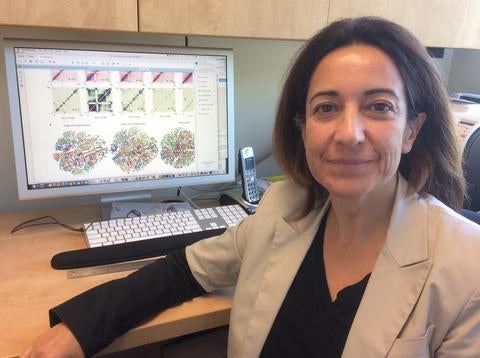College of Natural & Agricultural Sciences

An international research team led by scientists at the University of California, Riverside, and the La Jolla Institute for Immunology has found that malaria parasite genomes are shaped by parasite-specific gene families, and that this genome organization strongly correlates with the parasite’s virulence.
The findings highlight the importance of spatial genome organization in gene regulation and the control of virulence in malaria parasites.
“Our results underscore the idea that compounds targeting proteins involved in establishing and maintaining the genome structure can interfere with parasite development and immune evasion,” said co-lead researcher Karine Le Roch, a professor in the UC Riverside Department of Molecular, Cell and Systems Biology. “Novel intervention strategies targeting the genome structure could thus mark a breakthrough for both vaccine and drug development against malaria.”
Study results appear in the Proceedings of the National Academy of Sciences.

Le Roch, co-leader Ferhat Ay, the Institute Leadership assistant professor of computational biology at La Jolla Institute for Immunology and an assistant adjunct professor at the UC San Diego School of Medicine, and colleagues investigated the 3-D genome organization in five malaria parasites and two related parasites to identify possible connections between genome architecture and pathogenicity. They found that in all five malaria parasites, genome organization is dominated by the clustering of parasite-specific gene families in 3-D space.
“Further, this 3-D genome organization in the nucleus plays a role in gene expression and pathogenicity of these deadly parasites,” said Le Roch, director of the UCR Center for Infectious Disease Vector Research and a member of the UCR Institute for Integrative Genome Biology.
The most virulent species of malaria parasites use an “antigenic variation” mechanism to alter their surface proteins and avoid the host immune response. The ability of the parasite to switch its antigenic profile correlates with the parasite’s high virulence. The more capable the parasite is in switching its antigenic profile, the more virulent the parasite.
The researchers found that the two most pathogenic human malaria parasites — Plasmodium falciparum and Plasmodium knowlesi — share unique features in the organization of gene families involved in antigenic variation. P. falciparum and P. knowlesi, they report, have evolved unique gene families — var and SICvar, respectively — that enable these parasites to undergo antigenic variation.
“The organization of other Plasmodium genomes is also driven by their virulence genes — but it is not as strongly seen in them as we see in P. falciparum and P. knowlesi,” Le Roch said.
When the researchers generated similar 3-D genome models for the related human parasites Babesia microti, which causes a malaria-like illness endemic in the United States, and Toxoplasma gondii, which causes toxoplasmosis in individuals with weakened immune systems, they found no association between genome structure and gene expression in general, suggesting this association is Plasmodium-specific.
“Our results, obtained by comparing the five malaria parasites with B. microti and T. gondii, strongly suggest that genome organization in malaria parasites has been shaped by parasite-specific gene families that affect virulence,” Le Roch said.
The researchers also observed significant differences between malaria parasites infecting primates and rodents, suggesting the various parasite lineages have evolved different strategies to survive in their respective hosts.
“One contributing factor could be the life span of the host,” Le Roch said. “Parasites infecting long-lived primates may require escape from adaptive immune responses to establish chronic infections and ensure transmission to a susceptible host, while parasites infecting short-lived rodent hosts may benefit from more flexible expression of their virulence genes.”
Next, the team plans on identifying the molecular components regulating the parasite-specific genes at the chromatin structure level with the goal of identifying new targets for novel therapeutic strategies.
Le Roch and Ay were joined in the research by scientists at UC Riverside; the University of Texas Health Science Center, San Antonio; Emory University; University of Oxford; Mahidol University; Columbia University; Yale School of Medicine, New Haven; University of Nottingham; and Johns Hopkins Bloomberg School of Public Health.
Le Roch was supported in the research by grants from the National Institutes of Health and UC Riverside.